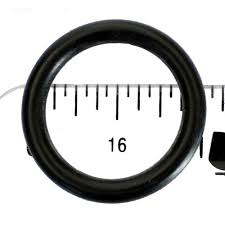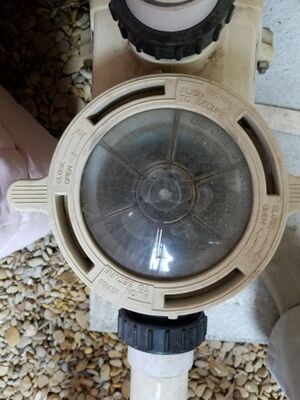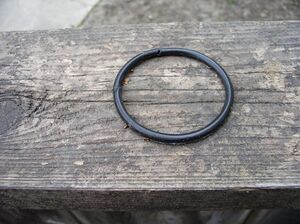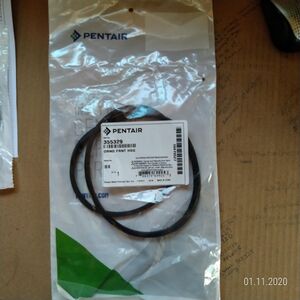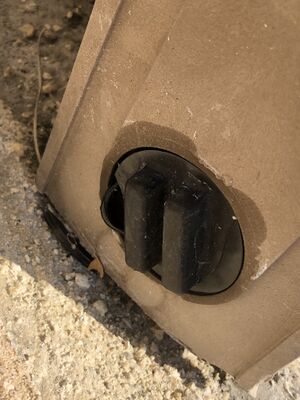| (8 intermediate revisions by the same user not shown) | |||
| Line 1: | Line 1: | ||
=O-Rings= | =O-Rings= | ||
| − | O-rings are used throughout a | + | O-rings are used throughout a pool's plumbing to create watertight seals. They range from large O-rings sealing the joints of a filter to small O-rings sealing rotating valve stems. O-rings also create watertight seals around threaded fittings and unions. O-rings are in pumps, filters, heaters, chlorinators, valves, actuators, and unions. Just about anywhere two surfaces come together and have water, you will find an O-ring sealing the joint. |
An O-ring is a doughnut shaped ring molded from an elastomer. | An O-ring is a doughnut shaped ring molded from an elastomer. | ||
| Line 6: | Line 6: | ||
[[File:O-Ring Pentair.jpg|thumb]] | [[File:O-Ring Pentair.jpg|thumb]] | ||
| − | The basic core polymer of an elastomeric compound is called | + | The basic core polymer of an elastomeric compound is called rubber. It is produced either as natural gum rubber in the wild, on commercial rubber plantations, or synthetically by the chemical industry. |
| − | Swimming pool pump and filter o-rings are typically made with EPDM rubber, while chlorinator o-rings are usually made of | + | Swimming pool pump and filter o-rings are typically made with EPDM rubber, while chlorinator o-rings are usually made of Fluorocarbon, Viton, or FKM. Many O-rings we see in pools are Buna N 55 hardness. Buna is a Nitrile compound and one of the most widely used O-ring elastomer compounds. The actual name is Acrylonitrile-Butadiene, but it can be referred to as Buna, Nitrile, or NBR. Depending on the compound, Buna has heat resistance up to 212F (100C) and cold flexibility between -30F and -70F. |
For more details about O-Rings see the [https://www.parker.com/content/dam/Parker-com/Literature/O-Ring-Division-Literature/ORD-5700.pdf Parker O-Ring Handbook] | For more details about O-Rings see the [https://www.parker.com/content/dam/Parker-com/Literature/O-Ring-Division-Literature/ORD-5700.pdf Parker O-Ring Handbook] | ||
[https://www.youtube.com/watch?v=aweDWuNkPw0 O-Rings? O-Yeah! How to Select, Design, and Install O-Ring Seals] is a great video about O-Rings. | [https://www.youtube.com/watch?v=aweDWuNkPw0 O-Rings? O-Yeah! How to Select, Design, and Install O-Ring Seals] is a great video about O-Rings. | ||
| + | |||
| + | The standard sizes used in the United States are defined by Aerospace Standard AS568B, Aerospace Size Standard for O-rings. That document, published by the Society of Automotive Engineers (SAE), lists the sizes of O-rings in six series or groups in both inches and millimeters. The first five series are based on cross-sectional diameter. The sixth series includes 20 sizes for boss seals. The standard sizes are also used for most military specifications. | ||
| + | |||
| + | The cross-sectional diameters range from 0.040 to 0.275 inches, and the inside diameters range from 0.029 to 25.940 inches. There are 369 standard sizes. | ||
| + | |||
| + | ID Inside Diameter OD Outside Diameter CS Cross Section .070″ .103″ .139″ .210″ .275″ | ||
| + | |||
| + | An interactive chart for standard o-ring dimensions is at [https://www.sealanddesign.com/technical/o-ring-sizes/ O-Ring Size Chart for AS568 Standard O-Ring Dimensions] | ||
==O-Ring Wear and Tear== | ==O-Ring Wear and Tear== | ||
| Line 20: | Line 28: | ||
Ozone, weather and atmospheric aging can make O-Rings brittle and lose their flexibility. O-Rings in rotating shaft seals in pumps, valves, and actuators can wear from the friction of the shaft movement. | Ozone, weather and atmospheric aging can make O-Rings brittle and lose their flexibility. O-Rings in rotating shaft seals in pumps, valves, and actuators can wear from the friction of the shaft movement. | ||
| − | If a threaded joint develops a drip suspect that an O-Ring needs to be replaced. | + | If a threaded joint develops a drip, suspect that an O-Ring needs to be replaced. |
| + | |||
| + | O-ring leaks on the pressure side of the pool equipment will leak water when the pump is running and suck air in when the pump shuts off. | ||
| + | |||
| + | O-ring leaks on the suction side of the pump will suck in air when the pump is running and may squirt water out when the pump shuts down. The pump basket O-ring under the pump lid and the pump drain plug O-rings are on the suction side and can create [https://www.troublefreepool.com/blog/2019/01/18/suction-side-air-leaks/ suction side air leaks]. | ||
| + | |||
| + | [[File:Pentair Pump Lid.jpg|thumb]] | ||
| − | When inspecting an O-Ring look for: | + | When inspecting an O-Ring, look for: |
| − | *small cuts, nicks or gashes, typically from installation damages. | + | *small cuts, nicks, or gashes, typically from installation damages. |
| − | *ragged edges | + | *ragged edges that appear tattered, typically due to excessive clearances. |
| − | *blisters, pocks, or pits on its surface | + | *blisters, pocks, or pits on its surface due to rapid pressure changes. |
| − | *radial cracks located on the highest temperature | + | *radial cracks are located on surfaces with the highest temperature. In addition, certain elastomers may exhibit signs of softening due to exposure to excessive heat. |
| − | *signs of degradation including blisters, cracks, voids or discoloration, due to chemical incompatibility. | + | *signs of degradation, including blisters, cracks, voids, or discoloration, due to chemical incompatibility. |
*circumferential splits within the flattened surface, usually due to excessive compression. | *circumferential splits within the flattened surface, usually due to excessive compression. | ||
*a flat surface parallel to the direction or motion. Loose particles and scrapes may be found on the seal surface, due to friction from a rough sealing surface. | *a flat surface parallel to the direction or motion. Loose particles and scrapes may be found on the seal surface, due to friction from a rough sealing surface. | ||
| Line 39: | Line 53: | ||
Check the Installation Manual for your equipment to find the manufacturers O-Ring part numbers. | Check the Installation Manual for your equipment to find the manufacturers O-Ring part numbers. | ||
| − | Many O-rings are | + | Many O-rings are commodities and can be found at hardware stores for much less than when packaged by a pool company. The advantage to paying pool company prices is that you know you are getting the correct size O-ring with the required materials. |
[[File:Pentair Pacfab O-Ring.jpg|thumb]] | [[File:Pentair Pacfab O-Ring.jpg|thumb]] | ||
| Line 45: | Line 59: | ||
[https://www.oringsusa.com/cart/ O-Rings, Inc.] is a leading online supplier of quality O-Rings. | [https://www.oringsusa.com/cart/ O-Rings, Inc.] is a leading online supplier of quality O-Rings. | ||
| − | [https://www.allorings.com/O-Ring-AS568-Standard-Size-Chart allorings] has | + | [https://www.allorings.com/O-Ring-AS568-Standard-Size-Chart allorings] has an O-Ring Size Chart - AS568 Standard O-Ring Sizes that finds AS568 o-ring standard sizes by cross-section, inside diameter, and outside diameter in their O-ring size chart and separate O-ring tolerance chart. |
| − | [http://www.aladdin1950.com/ Aladdin Equipment Company, Inc.] makes many of the O-Rings and GO-KITs manufacturers use. Note that Aladdin has | + | [http://www.aladdin1950.com/ Aladdin Equipment Company, Inc.] makes many of the O-Rings and GO-KITs manufacturers use. Note that Aladdin has its own proprietary O- numbering standard for O-Rings that is different than the AS-568 standard.<ref>https://www.troublefreepool.com/threads/where-do-you-buy-your-parts-for-rebuilding-pumps-and-motors.57836/post-507940</ref> Aladdin has a [http://www.aladdin1950.com/search-products Parts Cross Reference] on their website. |
==Tightening O-Rings== | ==Tightening O-Rings== | ||
| − | O-rings sit in a groove (or gland) and seal through compression. Any joint sealing with an O-ring should not be over-tightened. Over-tightening an O-ring joint can deform the O-ring and lead to leaks. Generally, fittings with o-rings only need to be "hand tight." You might need a wrench to loosen such a fitting, but you shouldn't use a wrench to put it back together if you can avoid it. If your hands are not strong enough to tighten a fitting enough, | + | O-rings sit in a groove (or gland) and seal through compression. Any joint sealing with an O-ring should not be over-tightened. Over-tightening an O-ring joint can deform the O-ring and lead to leaks. Generally, fittings with o-rings only need to be "hand tight." You might need a wrench to loosen such a fitting, but you shouldn't use a wrench to put it back together if you can avoid it. If your hands are not strong enough to tighten a fitting enough, you can gently use a wrench, but only to make the fitting more snug than you could with your hands. You don't crank the fitting down. |
| − | If a fitting with an O-ring is leaking do not simply crank it down to try | + | If a fitting with an O-ring is leaking, do not simply crank it down to try to stop the leak. That can crack the union or pipe or further deform the O-ring. Open up the joint and examine the O-ring for nicks, cracks, or deterioration. Replace the O-ring if it is damaged or has lost its flexibility and is deformed. |
| − | Below | + | Below is a filter drain plug that was overtightened and the O-ring deformed: |
[[File:O-Ring Filter Drain Deformed.jpg|thumb]] | [[File:O-Ring Filter Drain Deformed.jpg|thumb]] | ||
==O-Rings Need to be Lubed== | ==O-Rings Need to be Lubed== | ||
| − | All O-rings seal better when [[Pool Lube]] is used on them. [[Pool Lube]] should be used on all new O-rings and small leaks can often be stopped with an application of [[Pool Lube]]. | + | All O-rings seal better when [[Pool Lube]] is used on them. [[Pool Lube]] should be used on all new O-rings, and small leaks can often be stopped with an application of [[Pool Lube]]. |
| + | |||
| + | O-ring lube allows the three surfaces involved (the O-ring and the two components it's sealing together) to slide together as you tighten things up.<ref>https://www.troublefreepool.com/threads/gaskets-and-o-rings-and-lube-oh-my.197543/post-1742845</ref> Without it, the O-ring will pinch and bind and deform. It's the deformation that causes the leaks. And the premature wear. So the [[Pool Lube|lube]] is not really adding to the sealing properties of the O-ring; rather, it allows the O-ring to retain its correct shape and do its job. In that way, it can lengthen the life of the O-ring. Cleaning the O-ring and the surfaces it touches is important because a chunk of dirt can deform it and cause a leak. | ||
| − | + | Any rubber gasket you use should always have silicone lube applied unless expressly forbidden by the manufacturer. Rubber gaskets are imperfect, and there will always be a difference in size and shape between the groove they sit in and the gasket's dimensions. Lube is necessary to make up for those imperceptible differences and to create a watertight seal. Lube also adds a layer of material that protects the rubber from damage by water and chemicals. | |
Latest revision as of 20:44, 11 December 2024
O-Rings
O-rings are used throughout a pool's plumbing to create watertight seals. They range from large O-rings sealing the joints of a filter to small O-rings sealing rotating valve stems. O-rings also create watertight seals around threaded fittings and unions. O-rings are in pumps, filters, heaters, chlorinators, valves, actuators, and unions. Just about anywhere two surfaces come together and have water, you will find an O-ring sealing the joint.
An O-ring is a doughnut shaped ring molded from an elastomer.
The basic core polymer of an elastomeric compound is called rubber. It is produced either as natural gum rubber in the wild, on commercial rubber plantations, or synthetically by the chemical industry.
Swimming pool pump and filter o-rings are typically made with EPDM rubber, while chlorinator o-rings are usually made of Fluorocarbon, Viton, or FKM. Many O-rings we see in pools are Buna N 55 hardness. Buna is a Nitrile compound and one of the most widely used O-ring elastomer compounds. The actual name is Acrylonitrile-Butadiene, but it can be referred to as Buna, Nitrile, or NBR. Depending on the compound, Buna has heat resistance up to 212F (100C) and cold flexibility between -30F and -70F.
For more details about O-Rings see the Parker O-Ring Handbook
O-Rings? O-Yeah! How to Select, Design, and Install O-Ring Seals is a great video about O-Rings.
The standard sizes used in the United States are defined by Aerospace Standard AS568B, Aerospace Size Standard for O-rings. That document, published by the Society of Automotive Engineers (SAE), lists the sizes of O-rings in six series or groups in both inches and millimeters. The first five series are based on cross-sectional diameter. The sixth series includes 20 sizes for boss seals. The standard sizes are also used for most military specifications.
The cross-sectional diameters range from 0.040 to 0.275 inches, and the inside diameters range from 0.029 to 25.940 inches. There are 369 standard sizes.
ID Inside Diameter OD Outside Diameter CS Cross Section .070″ .103″ .139″ .210″ .275″
An interactive chart for standard o-ring dimensions is at O-Ring Size Chart for AS568 Standard O-Ring Dimensions
O-Ring Wear and Tear
O-Rings may last 5 to 10 years, they don't last forever. O-Rings will often wear out and need replacement before the equipment does.
Ozone, weather and atmospheric aging can make O-Rings brittle and lose their flexibility. O-Rings in rotating shaft seals in pumps, valves, and actuators can wear from the friction of the shaft movement.
If a threaded joint develops a drip, suspect that an O-Ring needs to be replaced.
O-ring leaks on the pressure side of the pool equipment will leak water when the pump is running and suck air in when the pump shuts off.
O-ring leaks on the suction side of the pump will suck in air when the pump is running and may squirt water out when the pump shuts down. The pump basket O-ring under the pump lid and the pump drain plug O-rings are on the suction side and can create suction side air leaks.
When inspecting an O-Ring, look for:
- small cuts, nicks, or gashes, typically from installation damages.
- ragged edges that appear tattered, typically due to excessive clearances.
- blisters, pocks, or pits on its surface due to rapid pressure changes.
- radial cracks are located on surfaces with the highest temperature. In addition, certain elastomers may exhibit signs of softening due to exposure to excessive heat.
- signs of degradation, including blisters, cracks, voids, or discoloration, due to chemical incompatibility.
- circumferential splits within the flattened surface, usually due to excessive compression.
- a flat surface parallel to the direction or motion. Loose particles and scrapes may be found on the seal surface, due to friction from a rough sealing surface.
Below is an O-Ring that was nicked and damaged:
O-Ring Sources
Check the Installation Manual for your equipment to find the manufacturers O-Ring part numbers.
Many O-rings are commodities and can be found at hardware stores for much less than when packaged by a pool company. The advantage to paying pool company prices is that you know you are getting the correct size O-ring with the required materials.
O-Rings, Inc. is a leading online supplier of quality O-Rings.
allorings has an O-Ring Size Chart - AS568 Standard O-Ring Sizes that finds AS568 o-ring standard sizes by cross-section, inside diameter, and outside diameter in their O-ring size chart and separate O-ring tolerance chart.
Aladdin Equipment Company, Inc. makes many of the O-Rings and GO-KITs manufacturers use. Note that Aladdin has its own proprietary O- numbering standard for O-Rings that is different than the AS-568 standard.[1] Aladdin has a Parts Cross Reference on their website.
Tightening O-Rings
O-rings sit in a groove (or gland) and seal through compression. Any joint sealing with an O-ring should not be over-tightened. Over-tightening an O-ring joint can deform the O-ring and lead to leaks. Generally, fittings with o-rings only need to be "hand tight." You might need a wrench to loosen such a fitting, but you shouldn't use a wrench to put it back together if you can avoid it. If your hands are not strong enough to tighten a fitting enough, you can gently use a wrench, but only to make the fitting more snug than you could with your hands. You don't crank the fitting down.
If a fitting with an O-ring is leaking, do not simply crank it down to try to stop the leak. That can crack the union or pipe or further deform the O-ring. Open up the joint and examine the O-ring for nicks, cracks, or deterioration. Replace the O-ring if it is damaged or has lost its flexibility and is deformed.
Below is a filter drain plug that was overtightened and the O-ring deformed:
O-Rings Need to be Lubed
All O-rings seal better when Pool Lube is used on them. Pool Lube should be used on all new O-rings, and small leaks can often be stopped with an application of Pool Lube.
O-ring lube allows the three surfaces involved (the O-ring and the two components it's sealing together) to slide together as you tighten things up.[2] Without it, the O-ring will pinch and bind and deform. It's the deformation that causes the leaks. And the premature wear. So the lube is not really adding to the sealing properties of the O-ring; rather, it allows the O-ring to retain its correct shape and do its job. In that way, it can lengthen the life of the O-ring. Cleaning the O-ring and the surfaces it touches is important because a chunk of dirt can deform it and cause a leak.
Any rubber gasket you use should always have silicone lube applied unless expressly forbidden by the manufacturer. Rubber gaskets are imperfect, and there will always be a difference in size and shape between the groove they sit in and the gasket's dimensions. Lube is necessary to make up for those imperceptible differences and to create a watertight seal. Lube also adds a layer of material that protects the rubber from damage by water and chemicals.


